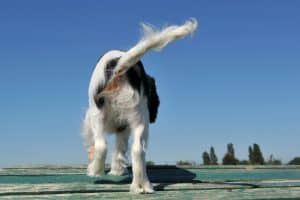Dog tail wagging: the language of joy and communication
Dog tail wagging is one of the most common and well-known signs of animal communication. This behavior is much more than a simple physical activity; it expresses deep emotional states and intentions. The term “dog tail wagging” has become synonymous with positive emotions and friendly communication in the dog world. But what does this phenomenon really mean, and how can we correctly interpret this form of communication in dogs? Let’s delve into the mysteries of dog tail wagging and discover the messages conveyed by this seemingly simple gesture.
The basics of tail wagging
Dog tail wagging primarily suggests joy and friendliness, but its meaning is much more nuanced. The tail’s position, speed, and rhythm all contribute to understanding the nuance of the message. A tail held high and wagged vigorously usually indicates excitement and happiness, while a tail held low and moved slowly can express uncertainty or shyness.
Emotional nuances

Communication tool
Tail wagging is not only directed at human friends. Dogs use this gesture for communication with their peers as well, signaling playfulness, dominance, or submission. Thus, dog tail wagging is a crucial element of nonverbal communication among dogs, helping them to effectively express their intentions and feelings.
Types of tail wagging and their meanings
Fast and High: When a dog wags its tail high and fast, it usually indicates that the dog is excited and happy. This often expresses a friendly approach or willingness to play.

- Low and slow wagging: This usually indicates worry, tension, or fear. The dog might be unsure about its environment or uncertain about the proper behavior.
- Very low or between the legs wagging: Most often, this signifies obedience, submission, or fear. The dog tries to appease the “threat” by indicating that it poses no danger.
- Circular wagging, like a helicopter: This is one of the most joyful wags, expressing complete happiness and excitement. It’s often seen when dogs are very happy to see their owners or a favorite toy. It can also be observed in dogs searching for a play item.
- Stiff tail: If the dog’s tail is stiff and barely moves, or only the tip vibrates, it could be a sign of intense attention or aggression. This posture suggests that the dog is alert and might be ready for confrontation.
Health considerations
The health aspects of dog tail wagging should not be overlooked. Sometimes, tail wagging does not indicate joy but rather a problem. For instance, if a dog constantly wags its tail to one side, this could point to a muscle issue or pain. It’s important for dog owners to pay attention to their pet’s behavior and consult a vet if they notice unusual signs.

Understanding dog tail wagging can contribute to a deeper and more satisfying relationship between humans and dogs. This behavior is not just a means of expressing joy and excitement but also part of a complex communication system that helps dogs convey their emotions and intentions. As we better understand and interpret the language of dog tail wagging, we become more capable of understanding and caring for our four-legged companions. Therefore, it’s important for owners and dogs to spend quality time together, as this is when they learn about each other. Observing body signals during this shared time increasingly enables owners to correctly interpret their own dog’s signals.
As dog trainers often say, one sign does not make a statement. Before judging a strange dog’s behavior based on its tail position, it’s important to clarify what the normal tail position for that particular dog is. A tail that’s carried high might be a sign of nervousness in some dogs, while for others, it could just be their usual tail position. 😉 Or you can read the article about kutya farokcsóválás in Hungarian.
Further interesting facts about living with a dog, or about the effects of medicinal mushrooms, different dog sports.
Source: Dr. Patricia McConnell, Stanley Coren


